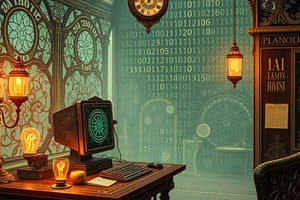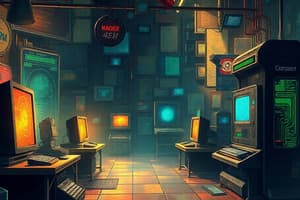Podcast
Questions and Answers
Who were the developers of the ENIAC machine at the University of Pennsylvania?
Who were the developers of the ENIAC machine at the University of Pennsylvania?
- Earl R.Larson and George Bush
- Atanasoff and Berry
- J.Presper Eckert and John Mauchly (correct)
- R.K.Richards and Mike Krapfl
What was the outcome of the patent case in 1973?
What was the outcome of the patent case in 1973?
- The case was dismissed due to lack of evidence
- Eckert and Mauchly's patents were upheld
- Eckert and Mauchly did not invent the automatic electronic digital computer (correct)
- Atanasoff's patents were declared invalid
What award did President George Bush give to Atanasoff in 1990?
What award did President George Bush give to Atanasoff in 1990?
- National Medal of Honor
- National Medal of Science
- National Medal of Technology (correct)
- Presidential Medal of Freedom
Who wrote the book Electronic Digital Systems?
Who wrote the book Electronic Digital Systems?
Who is credited with building the world's first electronic digital computer?
Who is credited with building the world's first electronic digital computer?
What was unique about the memory of the Atanasoff-Berry Computer?
What was unique about the memory of the Atanasoff-Berry Computer?
When did Berry die?
When did Berry die?
What was the significance of the Atanasoff-Berry Computer's binary system of arithmetic?
What was the significance of the Atanasoff-Berry Computer's binary system of arithmetic?
Why did Atanasoff approach Harold W. Anderson?
Why did Atanasoff approach Harold W. Anderson?
What was the outcome of the debate surrounding the ABC's place in computer history?
What was the outcome of the debate surrounding the ABC's place in computer history?
Flashcards are hidden until you start studying
Study Notes
The Development of the First Computing Machines
- Researchers from various disciplines, including physics, mathematics, and electrical engineering, contributed to the development of the first computing machines before the emergence of computer engineers and scientists.
Iowa State University's Role in Computing History
- Iowa State University's involvement in computing history began in 1937, when a physics professor and an electrical engineering alumnus (then a graduate student in physics) started working on the world's first electronic digital computer.
The Atanasoff-Berry Computer (ABC)
- The ABC was the world's first electronic digital computer, built by John Vincent Atanasoff, a professor of physics and mathematics, and Clifford Berry, a physics graduate student and electrical engineering undergraduate, at Iowa State University from 1937 to 1942.
- The ABC was the size of a big desk, weighed 750 pounds, and featured rotating drums for memory, glowing vacuum tubes, and a read/write system that recorded numbers by scorching marks on cards.
- The ABC introduced several innovations still used in today's computers, including:
- A binary system of arithmetic
- Separate memory and computing functions
- Regenerative memory
- Parallel processing
- Electronic amplifiers as on-off switches
- Circuits for logical addition and subtraction
- Clocked control of electronic operations
- Modular design
The Controversy Surrounding the ABC
- The ABC's place in computer history was disputed and led to a federal court case.
- J. Presper Eckert and John Mauchly, developers of the ENIAC machine, initially patented the electronic digital computer, but U.S. District Judge Earl R. Larson overturned the ENIAC patents in 1973, acknowledging Atanasoff as the inventor of the first electronic digital computer.
Recognition and Legacy
- President George Bush awarded Atanasoff the National Medal of Technology in 1990.
- Atanasoff died in 1995, while Berry died in 1963, before the patent controversy.
- Several books, including "Electronic Digital Systems" by R.K. Richards, have been written about Atanasoff, Berry, and the ABC.
Studying That Suits You
Use AI to generate personalized quizzes and flashcards to suit your learning preferences.




